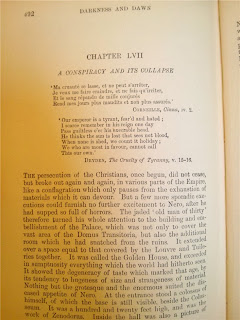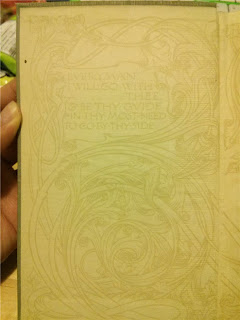 |
| Scholarly! |
It was fitting that A
Short History of the Irish People had a green cover, but what was
surprising was the presence of the dustjacket. Despite the sun-fading, the paper
jacket was in amazing condition for a book published in 1921. In addition to stating
that this was the second volume of the history, the cover also provided a synopsis
on the book, which was an interesting idea since there was more than enough
room on the inside flaps. Written by Mary Hayden and George A. Moonan, this was
a scholarly look into the backstory of Ireland that sold me based on design
principles alone. However, the title was a misnomer as my definition of a ‘short
history’ is something that fits on the back of a pamphlet or restaurant menu,
not a 572 page text.
 |
| Kind of wished this was the Mediaeval Ireland one. |
Having studied Gaelic literature in my undergrad, I was
familiar with the rich and very violent history of the Irish people so was
therefore quite excited to dig into this book. Unfortunately, it turned out
that part two of A Short History of the
Irish People covered the years from 1603 to the ‘present’, which in this
case meant 1921. Outside of the Great Famine and the establishment of Northern
Ireland, I knew very little about this particular time period and even less on
why this specific year was chosen for the volume split instead of a more
rounded number.
 |
|
Cúchulainn this ain't.
|
It turns out that 1603 marked the end of the Nine Years War
which drove out the Earls of Ireland and replaced them with a new government structure
that essentially put them under English rule. From here it was a lot of
hopscotching through numerous political events, culminating in the
establishment of the Irish Free State in 1921. It was pretty clear from the beginning
that the authors had a bias to the history, as any scholar of their nation
would, and at times there seemed to be some pretty heavy resentment and bitterness
to the events that unfolded under British rule.
 |
| To be fair, he was actually insane. |
While the text wasn’t a dry read, it also wasn’t very
exciting. Being written in the style of a school textbook, it was more
informational than colourful. What was
a fun read though, were the pencil scribbles and notes in the margins providing
running commentary on the events as they unfolded. My educated guess would be
that one of the previous owners of this book was an Irish nationalist of sorts.
 |
| Also reads like my love history... |
Another entertaining deviation from the straight history
were the sections on the literature of the period. Although these spanned only
a few pages, they did provide some insight on what was big in each of the
centuries A Short History of the Irish
People covered.
 |
| Isn't 'War on learning' pretty much every high school class? |
The biggest surprise, though, came halfway through the book
where an envelope was lodged between the pages. Opening it up, it was a
perfectly preserved subscription card, Christmas card order form, and envelope
to The Atlantic Monthly Company from 1947! Founded in 1857 by a group of
writers that included one of my most revered authors, Ralph Waldo Emerson, The Atlantic Monthly was a magazine that
had been printed monthly for almost a hundred and fifty years before changing
into The Atlantic, one of my favourite magazines. Still being
printed today, it was quite amazing to find a piece of this history randomly in
this book.
 |
| Most awesome surprise I've had in any book to date. |
Book rating: 8/10 (Interesting but nothing Wikipedia couldn’t tell you)
Random quote: “They
still talk about it here in 1942” (written in pencil next to the section stating
that future generations of Parnell’s countrymen will remember him)






























